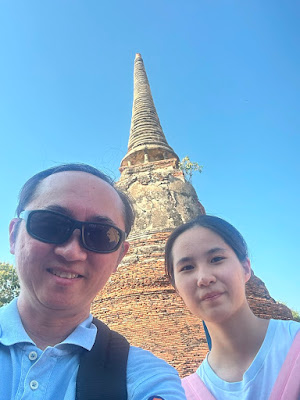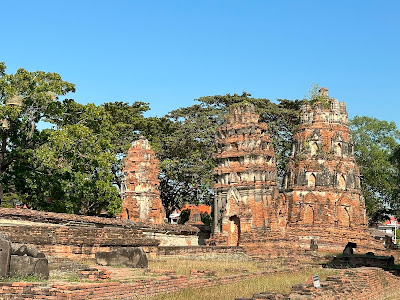The next temple where we visited was Wat Phra Mahathat, built in the 14th century, around the reign of King Borommatrailokkanat, who ruled Ayutthaya from 1448 to 1488. The name "Phra Mahathat" translates to "the Temple of the Great Relic," referring to the sacred relics of the Buddha believed to be housed at the temple.
Wat Phra Mahathat is renowned for its impressive ruins, which reflect the grandeur of the Ayutthaya Kingdom. The temple's most recognizable feature is its large, central prang (a Khmer-style tower), which rises majestically from the temple grounds. The prang, once covered in intricate carvings, is a symbol of Mount Meru, the center of the Buddhist cosmos. Though much of its detail has faded with time, the prang still stands as a reminder of the artistic and architectural achievements of the period.One of the most famous features of Wat Phra Mahathat is the iconic Buddha head entwined in the roots of a banyan tree. This surreal and captivating image is one of the most photographed and recognizable symbols of the Ayutthaya ruins. It is believed that the head of the Buddha statue was displaced during the invasion of the Burmese in the 18th century, and over time, the roots of the tree grew around it, creating this striking scene.
Wat Phra Mahathat holds profound religious significance for Buddhists. It is believed that the temple houses important relics of the Buddha, and for centuries, it has been a place of pilgrimage. The temple is associated with both royal and monastic practices, as it was one of the most prominent centers of religious life during the peak of the Ayutthaya Kingdom.
As we explored the temple ground, we saw many headless Buddha statues and according to the tour guide, the Buddha heads were stolen by thieves in the ancient days because there were usually gold and precious gems hidden within the Buddha heads.
Another saying is that during the Burmese invasion, the Burmese forces not only looted the city’s wealth but also destroyed many of its sacred symbols, including the Buddha statues. The heads of many of these statues were deliberately severed, likely as a form of symbolic desecration or to steal valuable materials (in some cases, the heads were made of gold or other precious metals).
The temple complex contains the remains of numerous chedis, viharns, and other structures.
The temple's central prang (Khmer-style tower) was once a grand structure, but now only its ruins remain. Surrounding the central prang are several smaller chedis (stupas), which once housed relics and were used for religious purposes. These chedis reflect the temple's importance as a center of Buddhist practice and its role in the royal religious rituals.Wat Phra Mahathat is a UNESCO World Heritage site and a popular tourist destination in Ayutthaya. Though much of the temple has been damaged by the Burmese invasion in 1767, it remains one of the most important landmarks in the city.
We noticed that some of the Chedis were slightly tilted. It can be attributed to structural damage caused during the Burmese invasion. And over time, natural elements like soil erosion, shifting ground, and earthquakes may have also contributed to the structural instability of the chedis, further exacerbating their slanting appearance.
With its magnificent ruins, the iconic Buddha head entwined in tree roots, and its historical significance, Wat Phra Mahathat is a must-visit destination for anyone exploring the ancient city of Ayutthaya


























No comments:
Post a Comment